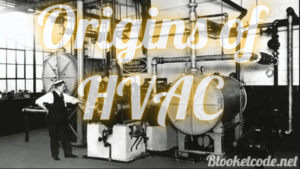Introduction
Heating, Ventilation, and Air Conditioning (HVAC) systems are an essential part of modern buildings, helping to regulate temperature, improve air quality, and ensure comfort.
However, HVAC systems have evolved significantly since their inception. From early rudimentary systems to today’s smart, energy-efficient technologies, the journey of HVAC development offers insight into technological advancements and changing priorities.
The Origins of HVAC

The industrial era marked the beginning of HVAC technology as we know it. Early systems were designed to improve worker conditions in factories where heat and air quality were major concerns.
- Primitive Heating Solutions: In the late 19th century, the development of steam-based heating systems allowed buildings to be heated more efficiently. Radiators and steam pipes made their way into factories and public buildings, setting the foundation for modern HVAC.
- Ventilation Challenges: As urban areas expanded, the need for better air quality became apparent. Ventilation technology started to take shape, especially in factories where dust and fumes were common.
The Birth of Modern HVAC
The 20th century was a time of rapid technological growth and marked the official beginning of modern HVAC systems.
Key innovations in heating, cooling, and air quality control emerged, driven by demands from both residential and commercial sectors.
- The Invention of Air Conditioning: In 1902, Willis Carrier developed the first modern air conditioning system to control humidity in a printing plant. This innovation revolutionized indoor environments, making cooling available for industries, homes, and public spaces.
- Forced-air systems: As technology advanced, forced-air systems began to replace steam-based heating. This new method allowed for better temperature control, and the concept of central air began to emerge, paving the way for HVAC as we know it.
HVAC Expands to Residential Spaces
Following World War II, HVAC technology became more accessible to homeowners, moving from industrial and commercial buildings into everyday residences.
- Advances in Home Cooling and Heating: During the 1950s, advancements in refrigeration technology made air conditioning systems more affordable. Residential HVAC units gained popularity in warmer regions, dramatically improving living standards.
- Electric and Gas Heating Systems: The 1960s and 1970s saw the adoption of electric and gas-powered heating systems, which offered more efficient heating options for residential properties.
Energy Efficiency and Smart HVAC Systems
With the rise of environmental awareness in the late 20th century, HVAC systems began incorporating energy-saving features, alongside advancements in digital technology.
Programmable Thermostat
In the 1980s, programmable thermostats became available, allowing homeowners and businesses to control heating and cooling on a set schedule, thereby reducing energy consumption.
Energy Efficiency Standards
Governments worldwide introduced energy efficiency standards, pushing manufacturers to design HVAC systems that used less power and had a lower environmental impact.
The introduction of Energy Star and similar programs led to the development of more efficient systems.
Smart HVAC Systems
The 2000s saw the integration of smart technology, such as sensors and Wi-Fi-enabled thermostats, allowing users to control and monitor their HVAC systems remotely.
Smart HVAC systems have become increasingly popular, offering users unprecedented control over indoor climate management.
Sustainable HVAC Technology
In response to climate change, the HVAC industry has shifted its focus toward sustainability.
Current innovations prioritize environmentally friendly solutions and efficient energy use.
- Renewable Energy Integration: Modern HVAC systems can now incorporate renewable energy sources like solar and geothermal power, reducing reliance on fossil fuels and lowering operational costs.
- Green Building Certification: LEED and other green certification systems emphasize the importance of sustainable HVAC systems in new constructions, encouraging the development of low-emission and energy-efficient HVAC designs.
- Carbon-Neutral HVAC Goals: Many companies are working toward carbon-neutral HVAC solutions, investing in low-global-warming-potential refrigerants and reducing overall energy consumption.
The Future of HVAC
As HVAC technology continues to evolve, future systems are expected to be even more efficient, sustainable, and user-friendly.
- AI and Machine Learning: The future of HVAC likely involves artificial intelligence and machine learning to optimize system performance, adjusting settings automatically based on usage patterns and environmental factors.
- Self-Maintenance Systems: Predictive maintenance, powered by smart sensors, will allow HVAC systems to diagnose and address issues before they become problems, reducing repair costs and extending system lifespans.
- Enhanced Indoor Air Quality (IAQ): With an increasing focus on health and wellness, future HVAC systems will likely integrate advanced IAQ technologies to ensure cleaner, healthier air in residential and commercial spaces.
Conclusion
From steam heating in factories to AI-driven smart systems, HVAC technology has come a long way.
The industry’s shift toward energy-efficient and sustainable practices reflects broader global trends focused on climate change and eco-conscious living.
As we look to the future, the continued evolution of HVAC technology promises not only greater comfort and convenience but also a more sustainable approach to managing indoor environments.




